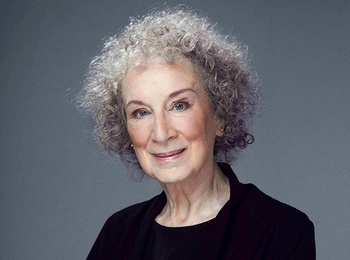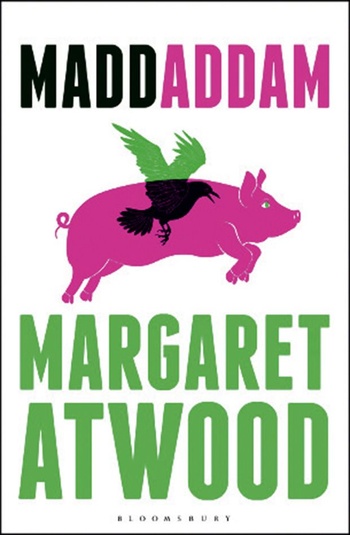(© Jean Malek)
The pre- and post-apocalyptic wasteland that the Canadian writer and Booker Prize winner Margaret Atwood explored for the first time ten years ago in Oryx and Crake, and which in 2009 became the battlefield of the equally blistering, bloodshot, and terrifying The Year of the Flood, has now, in the final instalment of the trilogy, definitively become the ground on which the future rises again. The story of MaddAddam.
Margaret Atwood: word from the wasteland


BOOK | MaddAddam ●●●
Margaret Atwood Bloomsbury, 416 p.
“Although MaddAddam is a work of fiction, it does not include any technologies or bio-beings that do not already exist, are not under construction, or are not possible in theory,” Margaret Atwood counters the customary fiction disclaimer you find on every novel. It reveals the scope of the project that the Canadian writer – at Flagey on 5 September! – had in mind with her trilogy. Not only is Atwood razor-sharp in her dissection of our two opposing but equally tenacious impulses to self-destruction and survival, her dystopian MaddAddam trilogy reads, between the lines, as a warning to humanity on the edge of the abyss, the reader she cherishes and provides with an extensive survival kit filled with necessary titbits of information. The MaddAddam trilogy is fiction, but the kind of fiction that comes so close to reality that it is overtaken by it more often than you’d like. Or are we mistaken when we see ever-increasingly recognisable parallels between our own world and the crazed consumer society in Atwood’s fiction, which on the eve of the apocalypse has relinquished all its power into the hands of the Corporations that increasingly drastically test the limits of shopaholics’ wallets, empathy, and tolerance?
Where Oryx and Crake and The Year of the Flood are superior, racing nightmares covered in jet-black ink, Atwood has opted for a slower pace in MaddAddam. There are fewer puzzles and more chatting; fewer sidesteps, more main road; less threat, more love. It makes this third instalment slightly less superlative than its predecessors. Or is that due to our fascination for destruction, while Atwood is focused on reconstruction? But we’re splitting hairs, we would live in whatever house Margaret Atwood calls home.
The story! The reboot of the world has taken place, the Great Emptiness has been created, survival has made room for life, albeit with reservations. The group of survivors condemned to each other is rather a motley crew. The depleted God’s Gardeners – an eco-freak show to some, but to others the only true alternative and the life buoy for straying humanity – are accompanied by the splinter group of the MaddAddamites, the “captive science brainiacs, working the evolution machines for Crake,” the young genius who channelled his disgust for what humanity had become into the development and spreading of “the global pandemic that had wiped out humanity”. Another part of the survivors’ club: Snowman-the-Jimmy, the childhood friend of Crake and a slightly less ingenious “word guy” blessed with a remarkable ability to stay alive. And in his wake, the Crakers, a flawless, chosen people that were intended to replace doomed humanity and that are childishly naïve and innocent in their bio-engineered purity. Crake, their maker, and Oryx, Jimmy’s great love who died in the apocalypse with Crake, become the gods of their universe.
Margaret Atwood follows Toby, once Gardener Eve Six, waiting and wanting, and badass MaddAddamite Zeb, whose personal history is uncovered, on the bumpy road to each other. Jimmy is breaking down - the copywriter is at a loss for words -, while nearly all of his former lovers seem to have somehow survived the end of the world. Ren and Amanda are recovering from their encounter with and abduction by the Painballers (prisoners who have become some sort of Roman gladiators, ruthless, bleached of language, and not quite human). And the Crakers’ naivety is being tested: “Oryx and Crake must be beautiful! Like the stories!”
It is in this field of tension, between the people counting their losses in the post-apocalypse and the Children of Crake, who have literally and figuratively just crawled out of the egg, that Margaret Atwood excells. All the more so when she guides that tension into the realm of language, whether it be spoken (the hilarious, nearly allegorical nighttime stories that Atwood displays as a partial dialogue), written (Toby’s book), or even sung (the otherworldly singing of the Crakers or the foul songs of Zeb). The hymns of the God’s Gardeners that provided the rhythm of The Year of the Flood have been exchanged for the nighttime stories that Toby tells the Crakers. “However dark, a darkness with voices in it is better than a silent void,” we read. Or stronger: “People need stories.”
Writing keeps Toby sane. Reading does the same for us. The little Craker Blackbeard becomes her pupil and learns to connect signs to meaning. Whether there is a place for literature after the apocalypse, we hear you ask?
5/9, 20.15, €8/10, Flagey, www.flagey.be
Margaret Atwood Bloomsbury, 416 p.
“Although MaddAddam is a work of fiction, it does not include any technologies or bio-beings that do not already exist, are not under construction, or are not possible in theory,” Margaret Atwood counters the customary fiction disclaimer you find on every novel. It reveals the scope of the project that the Canadian writer – at Flagey on 5 September! – had in mind with her trilogy. Not only is Atwood razor-sharp in her dissection of our two opposing but equally tenacious impulses to self-destruction and survival, her dystopian MaddAddam trilogy reads, between the lines, as a warning to humanity on the edge of the abyss, the reader she cherishes and provides with an extensive survival kit filled with necessary titbits of information. The MaddAddam trilogy is fiction, but the kind of fiction that comes so close to reality that it is overtaken by it more often than you’d like. Or are we mistaken when we see ever-increasingly recognisable parallels between our own world and the crazed consumer society in Atwood’s fiction, which on the eve of the apocalypse has relinquished all its power into the hands of the Corporations that increasingly drastically test the limits of shopaholics’ wallets, empathy, and tolerance?
Where Oryx and Crake and The Year of the Flood are superior, racing nightmares covered in jet-black ink, Atwood has opted for a slower pace in MaddAddam. There are fewer puzzles and more chatting; fewer sidesteps, more main road; less threat, more love. It makes this third instalment slightly less superlative than its predecessors. Or is that due to our fascination for destruction, while Atwood is focused on reconstruction? But we’re splitting hairs, we would live in whatever house Margaret Atwood calls home.
The story! The reboot of the world has taken place, the Great Emptiness has been created, survival has made room for life, albeit with reservations. The group of survivors condemned to each other is rather a motley crew. The depleted God’s Gardeners – an eco-freak show to some, but to others the only true alternative and the life buoy for straying humanity – are accompanied by the splinter group of the MaddAddamites, the “captive science brainiacs, working the evolution machines for Crake,” the young genius who channelled his disgust for what humanity had become into the development and spreading of “the global pandemic that had wiped out humanity”. Another part of the survivors’ club: Snowman-the-Jimmy, the childhood friend of Crake and a slightly less ingenious “word guy” blessed with a remarkable ability to stay alive. And in his wake, the Crakers, a flawless, chosen people that were intended to replace doomed humanity and that are childishly naïve and innocent in their bio-engineered purity. Crake, their maker, and Oryx, Jimmy’s great love who died in the apocalypse with Crake, become the gods of their universe.
Margaret Atwood follows Toby, once Gardener Eve Six, waiting and wanting, and badass MaddAddamite Zeb, whose personal history is uncovered, on the bumpy road to each other. Jimmy is breaking down - the copywriter is at a loss for words -, while nearly all of his former lovers seem to have somehow survived the end of the world. Ren and Amanda are recovering from their encounter with and abduction by the Painballers (prisoners who have become some sort of Roman gladiators, ruthless, bleached of language, and not quite human). And the Crakers’ naivety is being tested: “Oryx and Crake must be beautiful! Like the stories!”
It is in this field of tension, between the people counting their losses in the post-apocalypse and the Children of Crake, who have literally and figuratively just crawled out of the egg, that Margaret Atwood excells. All the more so when she guides that tension into the realm of language, whether it be spoken (the hilarious, nearly allegorical nighttime stories that Atwood displays as a partial dialogue), written (Toby’s book), or even sung (the otherworldly singing of the Crakers or the foul songs of Zeb). The hymns of the God’s Gardeners that provided the rhythm of The Year of the Flood have been exchanged for the nighttime stories that Toby tells the Crakers. “However dark, a darkness with voices in it is better than a silent void,” we read. Or stronger: “People need stories.”
Writing keeps Toby sane. Reading does the same for us. The little Craker Blackbeard becomes her pupil and learns to connect signs to meaning. Whether there is a place for literature after the apocalypse, we hear you ask?
5/9, 20.15, €8/10, Flagey, www.flagey.be
Read more about: Expo
Fijn dat je wil reageren. Wie reageert, gaat akkoord met onze huisregels. Hoe reageren via Disqus? Een woordje uitleg.